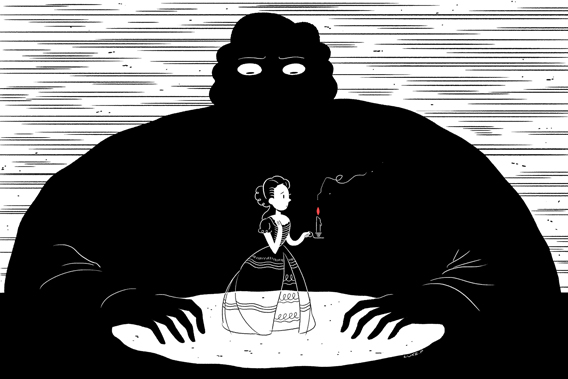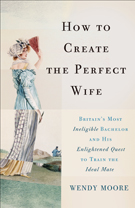
Slate is an Amazon affiliate and may receive a commission from purchases you make through our links.
Chauvinist Pygmalion
In 18th century England, Thomas Day adopted a little girl and tried to mold her into the perfect wife.

Illustration by Luke Pearson
There’s no shortage of historical figures whose private actions failed to live up to their public moralizing. (Thomas Jefferson, anyone?) But few embraced that hypocrisy as jaw-droppingly as Thomas Day, the subject of Wendy Moore’s How to Create the Perfect Wife: Britain’s Most Ineligible Bachelor and His Enlightened Quest to Train the Ideal Mate. The Pygmalion-gone-wrong story of a man who adopted two orphans in hopes of making one his wife is bizarre, true, and thoroughly compelling, touching on the folly of uncritically embracing extreme parenting methods, the futility of trying to force someone to be who you want, and the danger of philosophy when wielded by young men who don’t understand it.
An intellectual who lived in the 18th century, Day held many views that were impressively progressive and egalitarian for his time. He campaigned to end slavery and supported the American revolutionaries. Though wealthy, he lived simply and gave much of his fortune to charitable causes. He preferred plain clothes, once requesting that his tailor make his new suits “as free from tawdriness, & Frippery as possible.” He was one of the first to write a book specifically for children, and he didn’t even like to eat meat or kill spiders. Though his manners were lacking (“unsuitable to his rank in life,” one suitor’s father apparently complained) and his personality off-putting and dour, several influential writers and scientists embraced him, considering his eccentricities as mere side effects of his exceptional morality.
But for all his talk about liberty, Day was, frankly, a hypocritical misogynist—even for his time. “If the whole female Sex cannot furnish one single rational Woman,” he whined, “I must make use of them in that Manner for which alone Nature has perhaps intended.” Yet he very much wanted a wife, and his requirements for her make Julia Allison—she of the 88-point checklist—look laid back. Mrs. Day was to be pretty—he was particularly insistent that she possess plump, white arms—but not vain or fashionable; smart but not above her station; psychologically and physically constituted for housekeeping (he wanted few if any servants); and receptive to his criticism, which by Day’s design would be constant. He could occasionally convince a woman to consider him romantically—he was engaged several times—but these entanglements fell apart once the women realized exactly how dreary their married lives would be. So in his early 20s, he set forth on his life-defining scheme to raise his own wife.
Like many an Enlightenment chap, Day was quite taken with Rousseau—especially Emile: or, On Education. Emile follows its titular hero through an unconventional boyhood: Exposure to cold and the elements foster Emile’s physical hardiness, while freedom to pursue his intellectual passions develops his strong sense of curiosity and morality. Rousseau tried in vain to tell his readers that Emile was a philosophical treatise, not a childrearing guide, but nevertheless some misguided parents in France and England followed it as rigorously as a new mom in the 1950s would her Dr. Spock. Day decided to apply the Emile methods to a girl, and to eventually make her his wife. Well, two girls, since one always needs a backup.
With the help of a married friend and a very generous donation that likely helped lower any red flags, Day, then in his early 20s, was able to acquire two lovely orphans, ages 11 and 12. (They were technically “apprenticed” to his married friend.) Soon after, he changed the girls’ names to Sabrina and Lucretia, and off the odd trio went to France. The purpose was not to imbue in them a French sophistication, but to isolate them from any other English speakers, so that they would be free from other influence. Day seemed to hate most women, but he held particular disregard for French women and the power he believed they held in their marriages: “The most disgusting sight of all is to see that sex, whose weakness of body, and imbecility of mind, can only entitle them to our compassion and indulgence, assuming an unnatural dominance, and by regulating the customs, the manners, the lives and the opinions of the other sex, by their own caprices, weakness, and ignorance.”

After a rocky sojourn in France, in which he taught the girls to read but also nearly drowned them in an attempt to toughen them physically, Day gave his final rose to Sabrina and sent the other off with a little money. He then spirited the poor 13-year-old whom he intended to make his bride off to the English countryside, where, among other things, he tortured her physically by dripping hot wax on her back and arms while insisting she not scream in pain. But she did not know what goal she was working toward, as Day never disclosed that he had hoped to marry one of them. They had thought they were training to be housemaids.
The question that runs throughout How to Create a Perfect Wife is: How did neither Day nor his do-gooding abettors realize that this was torture? “The philanthropist who could not pass a beggar without parting his money, the nature lover who felt he did not have the right to stamp on a spider let alone mistreat a horse, the humanitarian who opposed slavery because it was the ‘absolute dependence of one man upon another,’ was utterly convinced he had every right to keep a young woman subject to his total command and groom her to meet his desires,” Moore writes. Elsewhere she wonders whether Day was oblivious to the cruelty he inflicted or whether he thought “he had every right—as a wealthy, upper-class, educated man—to enact whatever cruelty he could dream up in his quest to create the perfect wife.”
And why didn’t any of his friends try to stop him? They knew that he was living with (though there’s no evidence he actually slept with) a pretty, malleable girl. Many in his circle were educated, progressive; some of the women, like writer Anna Seward, became friends with his charge, even though their letters suggest they were fully aware of the hot wax and other maltreatment Sabrina was subjected to. She existed in an unprotected social limbo—“a curious hybrid of privileged daughter and unpaid skivvy,” as Moore puts it—for a year before they finally pressured him to send her off to boarding school. But even then, Sabrina remained under Day’s control emotionally and financially, with Day considering her as a potential spouse for several more years.

Courtesy of Colin Crisford
Moore’s subject is appalling enough that it somehow feels wrong to find much of the material laughable—but nevertheless, it is. Day may have been some sort of genius, but his wildly off-mark interpretation of Rousseau should be included as a cautionary tale in all introductory philosophy classes. (See also: Jared Loughner and the troubled young men who cling to Nietzsche.) Doubling down on misinterpretation is a path to disaster—and certainly dour Day’s pursuit seems to have brought him little happiness.
But it’s also a cautionary tale to new parents who are desperate for a guiding philosophy. After all, if you ignore the (utterly, utterly creepy) part about Day wanting to make Sabrina his wife, his story is at its heart one of a man trying to keep one eye on a parenting guide and the other on his kid. In fact, maybe we should blame Rousseau for the endless, excruciating parent-blogger battles over whether we should let kids be kids, or instill discipline, or breast-feed to age 5. Moore writes that Emile “kickstarted a debate between huggers and hard-liners, between carrot and stick, which would ricochet down the centuries" and "would change not just educational practice but basic ideas about childhood fundamentally and forever.” From Emile, then, we can trace those who would hew rigidly to attachment, minimalist, or authoritarian parenting—and also those who would drive themselves crazy trying to find a style that’s just right. Day was far too busy taking Rousseau literally to pay attention to his ward, who was actually quite fond of him until she learned about the true nature of his experiment.
Given that Day tried to mold not just Sabrina, but also a friend’s son and every woman he ever saw romantically, perhaps the most karmically delicious part of How to Create the Perfect Wife is when Day himself tries to become someone he is not. Under the sway of a fashionable woman, he heads to France for his own dramatic makeover, adopting his much-loathed frippery and remaking his appalling manners. But when he returns to claim his lady love, everyone is aghast: He is completely unconvincing. He quickly discards his new look and returns to the simple life he idealized so joylessly. But in the end, his grander, more awful experiment made him look more a fool than those whose shallowness he so despised.
---
How to Create the Perfect Wife: Britain’s Most Ineligible Bachelor and His Enlightened Quest To Train the Ideal Mate by Wendy Moore. Basic Books
See all the pieces in this month’s Slate Book Review.
Sign up for the Slate Book Review monthly newsletter.
